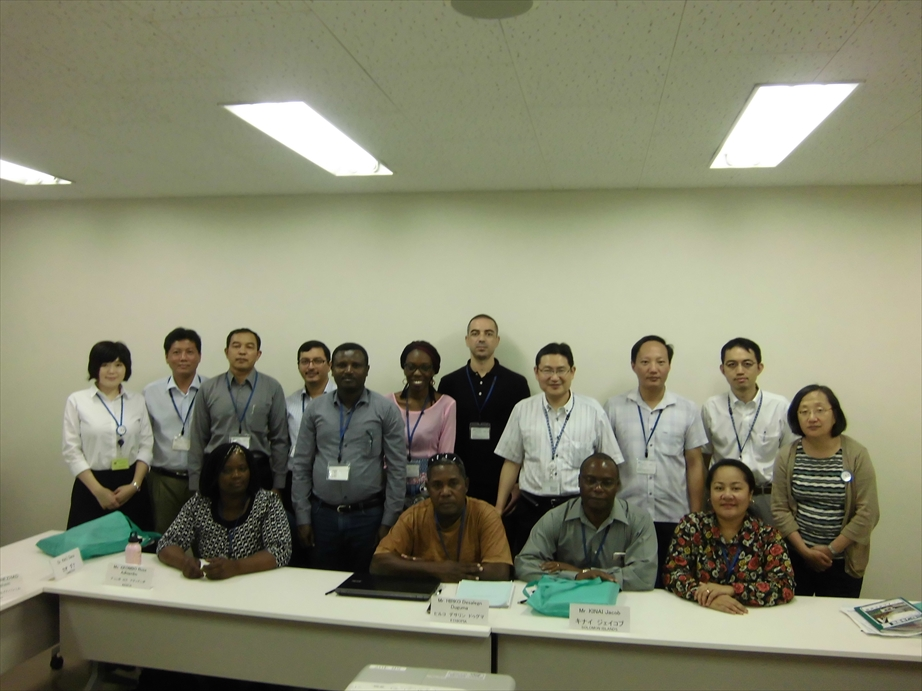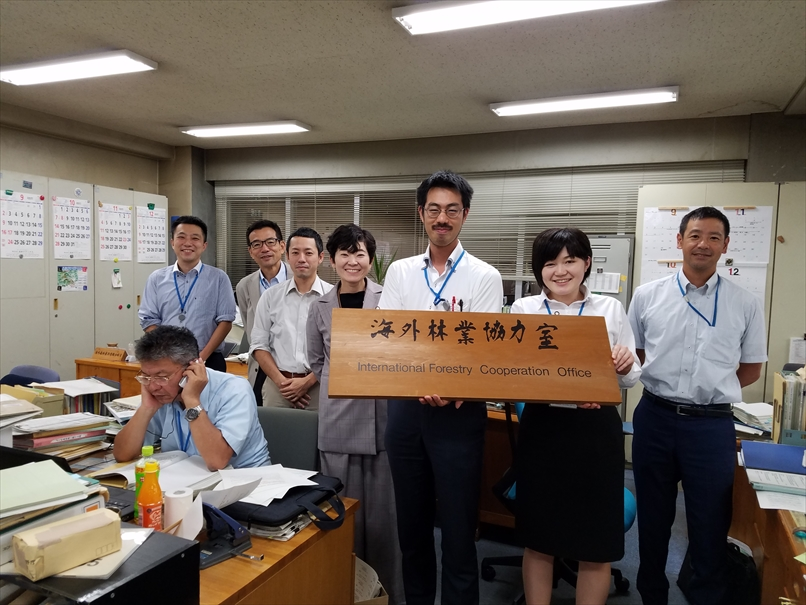【インターンシップレポート】「農林水産省林野庁」岡本奈緒美
2018年11月21日 12時08分生命環境科学研究科 地球科学専攻 岡本奈緒美

私が林野庁にインターンシップを希望した理由の1つは、自然保護や生態系に関わる仕事につきたいと考えたからです。私は現在、地質学を専攻していますが、野外調査へ行くたびに自然が好きだと感じ、それらを守り、次の世代に残していきたいと感じています。今回のインターンシップでは自然保護に関連して、自然をそのままの形で保護するだけでなく、人の手を入れて整備していくことで持続的に森林を管理していく、という考え方を知ることができました。実は私はインターンに行く前は、自然を保護するという観点から見て、「人の手が入る」ということにマイナスなイメージを持っていました。そのため、林野庁で森林整備や保全の考え方を初めて知った時、私がやりたい自然保護と考え方が異なるかもしれないと考えたことがありました。しかし、インターンシップ中に治山という言葉に出会い、また災害の復興のための治山、防災のための治山など治山にも様々な方法があることを知り、治山が本来起こるはずの自然のサイクルを人の手で補助し、早め、回復させるものであることを理解できました。インターンシップに参加したことで、人の手を加えて森林を整備することへの理解が深まり、このような方法もあるのだと考えられるようになりました。また、自然のサイクルを補助し、促進させる「治山」という事業に非常に興味を持ち、関わりたいと感じました。

〇はじめに
私は平成30年9月3日(月)~9月14日(金)の2週間(実働日数10日)にわたり、農林水産省林野庁にてインターンシップをさせて頂きました。私たちが住む日本では、国土面積の約7割を森林が占めており、森林は国土の保全、水源の涵養等の多面的機能の発揮を通じて、国民生活に様々な恩恵をもたらす「緑の社会資本」とも言われています。森林の健全な育成を通じて、国土機能など公益的機能を高度に発揮させること、さらに木材の安定供給を図るなど、民有林行政と国有林野事業を行うのが林野庁の大きな役割です。
その中でも私は今回、霞が関にある林野庁本庁、森林整備部計画課海外林業協力室という部署にてインターンシップに参加する機会を頂きました。海外林業協力室は、日本の林業の歴史の中で培われてきた植林や治山等の技術の海外への発信を含む、途上国への技術協力や、気候変動に関する国際的な適応・緩和策に関する事業を実施するなど、林野庁における国際協力を担う部署です。そのため、海外林業協力室には海外勤務経験者が多く、ケニアやパラグアイ等、海外での業務経験についてお話を伺うこともできました。
〇インターンシップの内容
インターンシップの内容は、「途上国における防災・減災」についての資料を収集し、取りまとめ、レポートを提出するというものでした。また、それ以外にも外国からの訪問者のお話を伺ったり、JICAの研修を傍聴し、国際協力取組や海外での植林等の実情について学んだり、資料の作成や翻訳等の事務作業を体験させていただいたりしました。
減災・防災に関するレポート作成においては、主に、資料収集・アイデアの醸成というプロセスを体験させていただきました。イメージしていた業務のスタイルとは異なるものでしたが、新たなプロジェクトを立ち上げる際に基盤となるプロセスであり、発想に新しさやユニークさが求められる非常に重要な業務に携わらせて頂きました。今回作成したレポートも今後の海外林業協力の在り方や展開方向の検討に資するものになれば良いな、と感じています。また、インターンシップ最終日には、レポート内容を海外林業協力室の皆様の前で発表し、質疑応答や意見交換をさせて頂きました。
資料の作成過程や発表後の意見交換において、林業や治山事業に関する動向について説明を受け、それらの活かし方について新たにアドバイスを頂いたり、過去の防災・減災の事例をご紹介いただいたりしたことで、より考えが深められたと感じています。このように、様々な方からの経験談やアドバイスを得つつ案を作成し、さらに意見交換することでより良いものに仕上げていく、というプロセスを通して大きなプロジェクトの計画・実施につながっていくのだということを実感でき、非常に貴重な経験となりました。
JICAの集団研修では、途上国からの出席者と共に森林・自然環境分野におけるJICAの取組や、森林保全に向けたNGO・NPOの取組についての講義を受けました。前者では、講義後の意見交換会で各国が現在日本に求めていることがそれぞれ異なっていることを知ることができました。また、海外への技術協力の形態が「先進国が指導する」ものではなく、「途上国自身が問題と解決策を提示し、先進国が支援する」という形態であることを実感しました。後者では、日本の若者の中で何をしたいのか、どんな職に就きたいのかがわからないという層が増加しているという問題が取り上げられました。この点について、私自身悩んでいる問題でもあったので理解しやすかったのですが、途上国の方々はどうしてそのような問題が出るのかが理解できない、という様子だったのが印象的でした。国の発展度合いや豊かさによって視点が全く異なるのだということを実感させられました。
JICAの集団研修では、途上国からの出席者と共に森林・自然環境分野におけるJICAの取組や、森林保全に向けたNGO・NPOの取組についての講義を受けました。前者では、講義後の意見交換会で各国が現在日本に求めていることがそれぞれ異なっていることを知ることができました。また、海外への技術協力の形態が「先進国が指導する」ものではなく、「途上国自身が問題と解決策を提示し、先進国が支援する」という形態であることを実感しました。後者では、日本の若者の中で何をしたいのか、どんな職に就きたいのかがわからないという層が増加しているという問題が取り上げられました。この点について、私自身悩んでいる問題でもあったので理解しやすかったのですが、途上国の方々はどうしてそのような問題が出るのかが理解できない、という様子だったのが印象的でした。国の発展度合いや豊かさによって視点が全く異なるのだということを実感させられました。
書類資料の作成や翻訳等の事務作業については、林野庁の職員の方々が普段されている業務の一部について経験してみたいという思いから、こちらから提案してやらせていただきました。資料の翻訳を行った際、特定の語句には定型的な翻訳方法や言い回しがあると指摘を受け、自分の配慮の至らなさを実感するとともに良い勉強となりました。
〇感想・学んだこと
〇感想・学んだこと
私が林野庁にインターンシップを希望した理由の1つは、自然保護や生態系に関わる仕事につきたいと考えたからです。私は現在、地質学を専攻していますが、野外調査へ行くたびに自然が好きだと感じ、それらを守り、次の世代に残していきたいと感じています。今回のインターンシップでは自然保護に関連して、自然をそのままの形で保護するだけでなく、人の手を入れて整備していくことで持続的に森林を管理していく、という考え方を知ることができました。実は私はインターンに行く前は、自然を保護するという観点から見て、「人の手が入る」ということにマイナスなイメージを持っていました。そのため、林野庁で森林整備や保全の考え方を初めて知った時、私がやりたい自然保護と考え方が異なるかもしれないと考えたことがありました。しかし、インターンシップ中に治山という言葉に出会い、また災害の復興のための治山、防災のための治山など治山にも様々な方法があることを知り、治山が本来起こるはずの自然のサイクルを人の手で補助し、早め、回復させるものであることを理解できました。インターンシップに参加したことで、人の手を加えて森林を整備することへの理解が深まり、このような方法もあるのだと考えられるようになりました。また、自然のサイクルを補助し、促進させる「治山」という事業に非常に興味を持ち、関わりたいと感じました。
上記で述べた通り、今回のインターンシップは業務の一部を体験するのみならず、林業や自然のもつ機能への学びを深める、というものだったように思います。私はこれまで林業に関わることがなかったため、インターンシップ期間中の課題として挙げられた森林という観点からの防災・減災という考え方自体が新鮮でした。そのため、予想以上に知識を頭に入れることに時間を費やしてしまい、担当の方には非常にご迷惑をおかけしてしまったと思います。また、我が国が途上国で防災・減災の取組を実施する際の具体策について、レポートでは具体案にまで十分言及できなかったことが非常に悔しく、心残りです。しかし最終日の発表会で、海外林業協力室の方に、レポート内で気候変動の緩和と適応、EBA(Ecosystem-based Adaptation)とEco-DRR(Ecosystem-based Disaster Risk Reduction)等の用語の違いが分かりやすく整理されているといっていただけ、少しでも海外林業協力室の方の助けになれたことが本当に嬉しかったです。
最後に、今回のインターンシップに参加したことで、自分のやりたいことや未熟な点に気づくことができました。また特に、時間のマネジメントの重要性やコミュニケーションにおける積極性、質問に対してすぐに的確な返答をする能力など、非常に当たり前のことがまだまだ未熟であったことを実感させられた2週間でした。今回のインターンシップで学んだことを無駄にせず、しっかりと今後の生活に活かしていけるよう意識していこうと思います。
末筆ですが、このような機会を与えてくださった先生方、林野庁計画課の皆様、海外林業協力室の皆様、インターンシップ中に様々な面においてご助力頂いた皆様、インターンシップを受け入れていただき、2週間という長い期間なにかと気にかけてくださり、誠にありがとうございました。心からの感謝を申し上げます。このインターンシップで得られた貴重な経験や知識、気づきを活かし、今後も精進してまいります。2週間、たいへんお世話になりました。ありがとうございました。